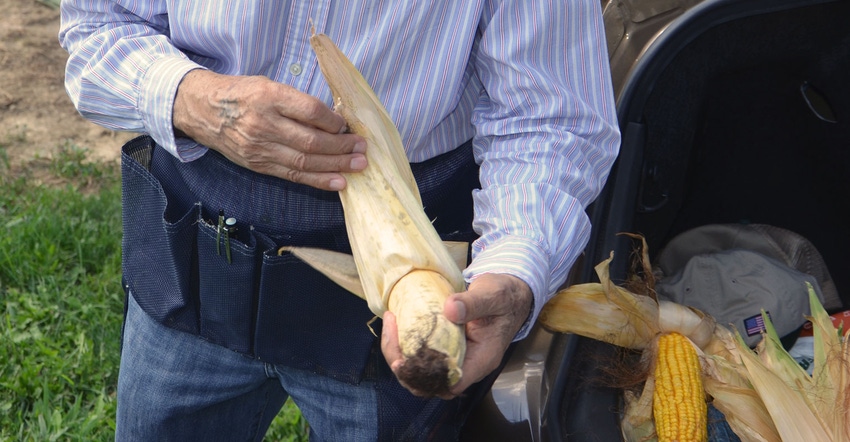
You’re going to judge hybrids first by what the yield monitor says. How many bushels per acre did a hybrid produce? That’s natural. It’s what you get paid on.
However, Dave Nanda says yield is not the only way hybrids differ. Many different characteristics of a plant are partly what add up to different yield monitor readings. You may select hybrids first and foremost based on yield, but Nanda suggests considering other factors.
Nanda is a former plant breeder and now an independent crop consultant in Indianapolis. Corn Watch ’18 is sponsored by Seed Genetics-Direct, Washington Court House, Ohio.
Plant characteristics
How well do you know your hybrids? This is not an all-inclusive list, but here are 10 ways hybrids may differ:
1. Number of husks per ear. Some hybrids put more husks around the ear than others. It’s in their DNA. The Corn Watch ’18 field was planted with two hybrids. One tends to put on eight husks, while the other typically has nine. Number, length and thickness of husks can vary from hybrid to hybrid. All three factors can affect how quickly a hybrid dries down in the field.
2. Plant height. Some hybrids are naturally taller. Environment will impact plant height in any one season, but a hybrid that is tallest one year will likely be tallest the next year.
3. Ear placement. Where ears grow on the stalk in relation to the ground isn’t an accident, Nanda says. It’s a factor plant breeders can select for in breeding programs. Some prefer hybrids with lower, uniform ear placement because they believe it gives those hybrids an advantage when it comes to withstanding storms.
4. Number of kernel rows per ear. This is highly controlled by genetics, Nanda says. If conditions are favorable early in the season, when the plant makes the decision about kernel row number, the hybrid is more likely to reach its full potential.
The fixed-ear-type hybrid in the Corn Watch ’18 field typically puts on 18 rows. The other hybrid, a flex-ear type, puts on 14 rows, and will put on 16 if conditions are favorable. However, it will form a longer ear with more kernels per row.
5. Number of branches per tassel. You can often pick out two different hybrids visually by the structure of their tassels, Nanda says. In the Corn Watch ’18 field, one hybrid has tassels with eight branches, while the other has tassels with 12 to 13 somewhat shorter branches. Breeders select for smaller tassels for efficiency when they have a choice, since all tassels produce tremendous amounts of pollen anyway, Nanda notes. Plus, smaller tassels shade leaves less.
6. Number of leaves per plant. If you count plant leaves on two different hybrids, the number may or may not be the same. Usually a difference in leaf count won’t be more than one to two leaves, Nanda says. Number of leaves is somewhat controlled by genetics. Nanda demonstrated many years ago that earlier-maturity hybrids tend to have fewer leaves than later-maturing hybrids.
7. Size of ear leaf. The ear leaf is the one you’re trying to protect when you spray fungicides earlier in the season, Nanda says. Based on measurements earlier in the season, ear leaves on different hybrids can vary. Some hybrids produce slightly longer ear leaves than others. The width at the widest point may also vary by a half-inch or more. A bigger ear leaf provides more area for photosynthesis.
8. Brace roots. Hybrids differ in number of brace roots. Plant breeders select hybrids with more brace roots when possible because those plants tend to be sturdier and suffer less root lodging in stormy weather.
9. Ear shank length. Length of ear shank and strength of attachment to plants can vary among hybrids. This impacts ear retention and number of ears prone to drop off in the fall.
10. Ear angle. Are ears upright or bent over at maturity? Nanda says this factor affects the hybrid’s resistance to ear rots. It can also factor into drydown rate.
About the Author(s)
You May Also Like




